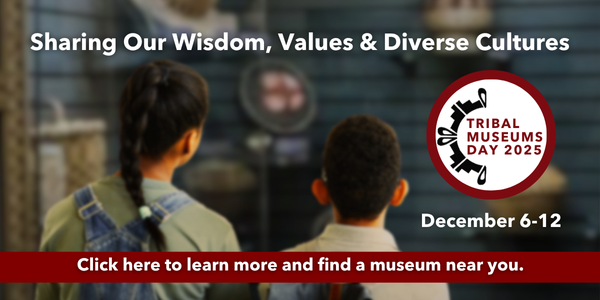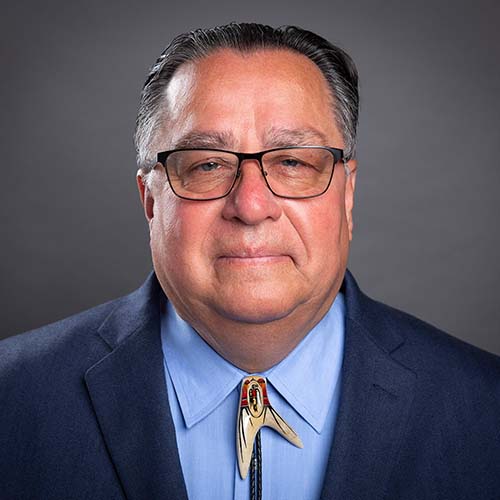
- Details
- By Association on American Indian Affairs
Across the country today, museums are being forced to reckon with the truth. For centuries, most mainstream museums were built from taking — taking objects, taking stories, taking lands. They displayed the Ancestors of Native Nations under the banner of “education,” while silencing the very Peoples those Ancestors came from.
Tribal Museums are the opposite. They are places of return — returning stories to their original tellers and returning visitors to respectful relationships with place.
On Saturday, December 6, 2025, the Association on American Indian Affairs invites the public to celebrate the Fourth Annual Tribal Museums Day, a weeklong national event honoring the more than 150 Tribal Museums and Cultural Centers across Native Country that are redefining what museums can and should be. A live-stream event at 2 p.m. ET will kick off the celebration, featuring interviews with cultural leaders and museum representatives. Audiences can join on the Association’s YouTube, Facebook, and LinkedIn pages and explore more at Indian-Affairs.org.
“Everyone is welcome to experience Tribal Museums,” said Shannon O’Loughlin, citizen of the Choctaw Nation of Oklahoma and CEO for the Association. “When visiting, engage with the experts, ask questions, and take time to explore the museum’s offerings. These are living spaces — they reflect the voices and knowledge of our Peoples.”
Reclaiming the Story of America
We are standing in a pivotal moment for museums and cultural storytelling. Across the country, mainstream institutions are finally being held accountable under the Native American Graves Protection and Repatriation Act—a law passed 35 years ago but ignored for far too long. For decades, institutions have claimed authority over Native identities and sacred belongings. Now, as the law compels their return, they face hard truths about theft, harm, and colonial narratives that were never theirs to tell.
At the same time, political censorship is growing — exhibitions canceled, funding terminated, even history books rewritten for daring to tell the facts and evidence of Native Ancestors. When truth becomes controversial, authenticity becomes our power.
That is where Tribal Museums rise to the top.
Tribal Museums are not beholden to those systems — not to state or federal censors, not to academic gatekeepers, and not to donors who want ownership over diverse Native cultures. Tribal museums are governed by Native Nations, accountable to their own citizens, lands, and values. Their programs are led by Native experts: elders, educators, and culture bearers, ensuring that stories are told by those who carry them.
Where Sovereignty Lives
Tribal Museums are living spaces grounded in sovereignty — places where law, language, and lifeways are not simply remembered but practiced. They are also vital economic engines, supporting local jobs, artists, and programs that strengthen self-determination and education within their Nations. Many will celebrate Tribal Museums Day with free or discounted admission, cultural demonstrations, special exhibits, and holiday markets.
These institutions prepare visitors to meet sacred places with respect and to understand how culture and conservation are inseparable. They help visitors see that the story of this country is not a single narrative — it is a tapestry of sovereign Nations whose histories, innovations, and spiritual connections continue to shape this land.
“In a world flooded with AI images, misinformation, and synthetic voices,” said O’Loughlin, “people are searching for something human — something real. That truth lives in our diverse museums. When someone walks through a Tribal Museum, they’re not just seeing exhibits and history — they are interacting with Native Peoples from the past and present working to protect our futures.”
Celebrating the Future, Not the Past
This year’s live-stream event will feature museums including the Chickaloon Village Traditional Council’s Nay’dini’aa Na’ Kayax’ Cultural Facility, the United Keetoowah Band’s John Hair Cultural Center and Keetoowah Museum, the MOWA Band of Choctaw Indians’ MOWA Choctaw Cultural Center and more. National partners, from major museums and Native media outlets to cultural tourism organizations, are helping expand awareness and participation.
While mainstream institutions scramble to reconcile with their pasts, Tribal Museums are building the future — one grounded in truth, reciprocity, and living culture. They are not simply cultural repositories; they are acts of sovereignty and resistance, where education, art, and innovation come together on Native terms.
To plan your visit, explore the Tribal Museums Map at Indian-Affairs.org. There, you’ll find listings, hours, and links to each museum’s website — and a deeper invitation to see this country as Native land. Tribal Museums are also charitable organizations, so visit and ask them how you can donate!
Because every Tribal Museum is more than a place to look. It’s a place to listen. A place to return.
Help us defend tribal sovereignty.
At Native News Online, our mission is rooted in telling the stories that strengthen sovereignty and uplift Indigenous voices — not just at year’s end, but every single day.
Because of your generosity last year, we were able to keep our reporters on the ground in tribal communities, at national gatherings and in the halls of Congress — covering the issues that matter most to Indian Country: sovereignty, culture, education, health and economic opportunity.
That support sustained us through a tough year in 2025. Now, as we look to the year ahead, we need your help right now to ensure warrior journalism remains strong — reporting that defends tribal sovereignty, amplifies Native truth, and holds power accountable.
 The stakes couldn't be higher. Your support keeps Native voices heard, Native stories told and Native sovereignty defended.
The stakes couldn't be higher. Your support keeps Native voices heard, Native stories told and Native sovereignty defended.
Stand with Warrior Journalism today.
Levi Rickert (Potawatomi), Editor & Publisher
